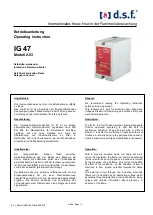
English-12
EXPANSION
Sets the zoom method.
FULL:
The image is expanded to 1200 x 1600 (in portrait mode) or 1600 x 1200 (in landscape mode) for MD212MC
and 1536 x 2048 (in portrait mode) or 2048 x 1536 (in landscape mode) for MD213MC/MD213MG, regardless of the
resolution.
ASPECT:
The image is expanded without changing the aspect ratio.
OFF:
The image is not expanded.
CUSTOM:
Refer to the ADVANCED OSD Controls menu section of the user’s manual for detailed instructions.
When digital QXGA (1536 x 2048 or 2048 x 1536) of the medical monochrome signal is connected, this function
does not operate (MD213MC/MD213MG only).
Color Control Systems (Only for MD212MC/MD213MC)
Color Control Systems:
Nine preset color settings.
For preset settings 1, 2, 3 and 5, the following levels can be adjusted:
TEMPERATURE:
Adjust the white temperature by increasing or decreasing this setting. A lower color temperature
will make the screen reddish and a higher color temperature will make the screen bluish.
WHITE (White Balance)
: If TEMPERATURE needs further adjustment, the individual R/ G/ B/ levels of the white
point can be adjusted. To adjust the R/G/B levels, CUSTOM must be showing as the TEMPERATURE selection.
HUE:
Adjusts the hue of each color*
1
. The change in color will appear on screen and the menu color bars will show
the amount of adjustment.
SATURATION:
Adjusts the color depth of each color*
1
. Press the “RIGHT” button and the color vividness increases.
OFFSET:
Adjusts the color brightness of each color*
1
. Press “RIGHT” button and the color Brightness increases.
*1: RED, YELLOW, GREEN, CYAN, BLUE and MAGENTA.
NATIVE, sRGB:
Original color presented by the LCD panel that is unadjustable.
PROGRAMMABLE:
The color tone that was set up with the special application software is reflected.
CLEAR BASE:
Color temperature setting for Clear Base x-ray film simulation.
BLUE BASE:
Color temperature setting for Blue Base x-ray film simulation.
NOTE:
To reset a poor image setting, turn on the monitor by using the power switch on the top (in portrait mode) or
left side (in landscape mode) of the monitor while holding “RESET” and “SELECT” buttons at the same time.
Tools
SHARPNESS
This function is digitally capable of keeping independently for crisp image at any time. It is continuously adjustable to
get as distinct or as soft an image as you prefer and is set independently for different timings.
DVI SELECTION
This function selects the DVI input mode (DVI-I). When the DVI selection has been changed, the computer has to be
restarted.
AUTO:
When using the DVI-D to DVI-D cable, the DVI SELECTION is DIGITAL.
When using the D-SUB to DVI-A cable, the DVI SELECTION is ANALOG.
DIGITAL:
DVI digital input is available.
ANALOG:
DVI analog input is available.
NOTE:
Depending on the PC and Video card used, or when another Video signal cable is attached, this function
may not operate.
VIDEO DETECT
Selects the method of video detection when more than one video input is connected.
FIRST:
When current video input signal is not present, then the monitor searches for a video signal from the other
video input port. If the video signal is present in the other port, then the monitor switches the video source input port
to the new found video source automatically. The monitor will not look for other video signals while the current video
source is present.
LAST:
When the monitor is displaying a signal from the current source and a new secondary source is supplied to
the monitor, then the monitor will automatically switch to the new video source. When current video input signal is not
present, then the monitor searches for a video signal from the other video input port. If the video signal is present in
the other port, then the monitor switches the video source input port to the new found video source automatically.
NONE:
The Monitor will not search the other video input port unless the monitor is turned on.















































